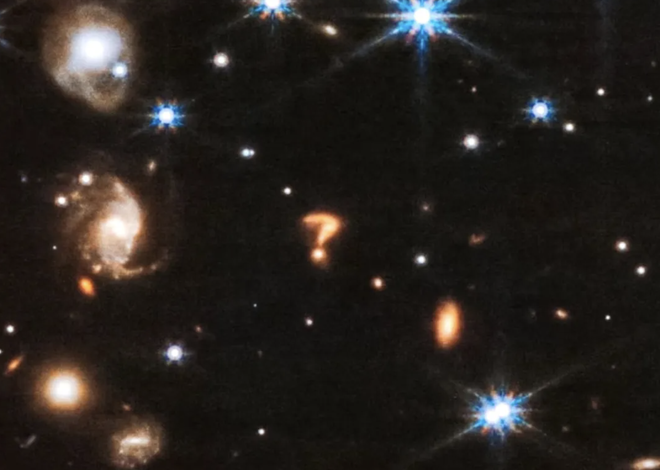A luminous symbol resembling a question mark, originating from the cosmos, has unexpectedly appeared in the background of NASA’s most recent imagery obtained through the James Webb Space Telescope. Experts are now speculating about the identity and nature of this enigmatic cosmic feature.
Unveiled on July 26, the initial near-infrared depiction portrayed a pair of fledgling stars denominated as Herbig-Haro 46/47. These stars are located within the Vela constellation of the Milky Way galaxy, situated at a distance of 1,470 light-years. These youthful stars are in an active phase of formation and are engaged in an intimate orbital dance around each other.
Although space and ground-based observatories have been scrutinizing these two stars since the 1950s, the extraordinary sensitivity of the Webb telescope has permitted the capture of the most intricate and high-resolution image to date. Distinguishing itself from its predecessors, the Webb telescope is designed to perceive the universe through longer wavelengths of light, offering a unique vantage point for exploration.
The James Webb Space Telescope serves as a beacon of insight into the origins of the cosmos. However, the presence of an enigmatic entity in the background of this image has sparked a multitude of questions, eclipsing the available answers. This cosmic question mark has yet to be subjected to meticulous observation and study, thus leaving scientists uncertain about its origin and composition.

Yet, grounded in the object’s form and position, scientists are constructing hypotheses. Matt Caplan, an assistant professor of physics at Illinois State University, noted, “The very first thing you can rule out is that it’s a star in the Milky Way… Stars always have these really big spikes… because stars are point-like.” This diffraction phenomenon, emanating from the mirror edges and camera supports, is a stark contrast to the anomaly’s structure. Caplan elaborated that the Webb telescope typically reveals six to eight stellar “prongs,” which unequivocally dismisses the possibility of it being a star.
Christopher Britt, an education and outreach scientist at the Space Telescope Science Institute, responsible for managing the Webb telescope’s scientific operations, posited the possibility of the object being a merger between two galaxies positioned billions of light-years away. This distance far surpasses the proximity of Herbig-Haro 46/47. According to Britt, the universe houses an array of galaxies beyond the confines of our own Milky Way, and their interactions, including collisions, lead to various configurations. These collisions can result in diverse shapes, even resembling a question mark.
While this specific entity’s appearance may be unprecedented, the amalgamation of galaxies into question mark-like configurations has manifested before. A contrasting variation of this form emerged from the Antennae Galaxies in the Corvus constellation. Moreover, most galaxies have undergone numerous interactions similar to this throughout their existence. However, these shapes are often transient, fleeting through cosmic time.
“The nature of space defies precise determination,” stated Caplan, underscoring the inherent complexity of cosmic movements. The Earth’s sun, partaking in its orbit around the galaxy, and the galaxy itself, composed of stars, experience gravitational forces tugging them in myriad directions. This ceaseless interplay underscores the dynamism of celestial mechanics.
This cosmic interplay is also the ultimate destiny for our own Milky Way galaxy, which will eventually merge with the Andromeda galaxy in approximately 4 billion years, as predicted by Britt. However, the precise configuration of this amalgamation remains uncertain.
Britt further hypothesized that the question mark shape might indicate a gravitational interaction between the two galaxies. “That hook of the question mark on the top looks a lot, to me, like what we call a tidal tail, where the stream of stars and gas has been kind of ripped off and has flown out into space,” he explained. To unravel the mysteries of this enigma, more data in the form of spectroscopic analyses is required, as emphasized by both Britt and Caplan. Such analyses could divulge essential details about the object’s distance and chemical composition.
“Nobody’s going to do this, though, because this is very much ‘a local man finds a chicken tender that looks like George Washington,’” Caplan said. “But there (are) observations you could make if you were motivated enough.”
